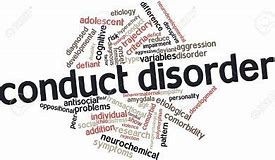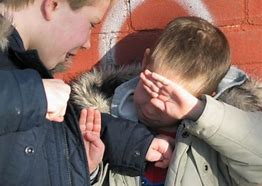
 Conduct disorder is a mental disorder that is diagnosed in children as early as nine years old and is characterized by persistent, aggressive or antisocial behavior (Hinshaw & Lee, 2003). An individual suffering from conduct disorder may fail to resist impulsive behaviors or temptations to perform an act that is harmful to self and others. Afterwards, the individual may feel an increased sense of gratification and will show a lack of regret, guilt, or empathy for one’s actions. The causes of conduct disorder (CD) can stem from heredity, psychological, or from the child’s environment. Persons suffering from conduct disorder may exhibit behaviors that would possibly break the law and or violate the rights of others (Butcher, Hooley & Mineka, 07/2013). Additional causes that may contribute to developing conduct disorder would be past abuse or the lack of bonds and trust between parent and child.
Conduct disorder is a mental disorder that is diagnosed in children as early as nine years old and is characterized by persistent, aggressive or antisocial behavior (Hinshaw & Lee, 2003). An individual suffering from conduct disorder may fail to resist impulsive behaviors or temptations to perform an act that is harmful to self and others. Afterwards, the individual may feel an increased sense of gratification and will show a lack of regret, guilt, or empathy for one’s actions. The causes of conduct disorder (CD) can stem from heredity, psychological, or from the child’s environment. Persons suffering from conduct disorder may exhibit behaviors that would possibly break the law and or violate the rights of others (Butcher, Hooley & Mineka, 07/2013). Additional causes that may contribute to developing conduct disorder would be past abuse or the lack of bonds and trust between parent and child.
Associated Disorders
Conduct disorder is also associated with Attention-Deficit/ Hyperactivity Disorder (ADHD) and Oppositional Defiant Disorder (ODD). Oppositional defiant disorders are characterized by persistent acts of aggressive or antisocial behavior, irritable moods argumentative, defiant, and vindictive behavior for a period of six or more months. In attention deficit/ hyperactivity disorder, the child may suffer from having difficulties staying focused and have impulsive tendencies. Approximately 25-30% of boys and 50-55% of girls with conduct disorder having a comorbid ADHD diagnosis (Waschbusch, 2002).
Symptoms of Conduct Disorder. (Butcher, Hooley & Mineka, 07/2013)
• The child lacks the sense of consequences.
• May exhibit socially inappropriate behavior.
• Lacks empathy.
• Unable to form bonds with their peers.
• May exhibit extreme rage.
• Lack self-control.
• Refuses to follow rules.
• May harm animals.
• Intimidates others.
• Sets fires.
• May threaten to kill others.
• Uses weapons.
• Has trouble with substance abuse.
• May commit sexual violence against the vulnerable.
• Will eventually drop out of school.
• Violent with parents, siblings, and extended family members.
• Steal/ lie.
• Shoplifts.
• Has multiple curfew violations.
• Destroys property.
• Causes fights.
• May have an extensive criminal record before the age of 13.
Gender Differences
Some research may prove that there are more males than females who suffer from conduct disorder and that it is more difficult to diagnosis females because males have the tendency to become more physically aggressive. (Lahey, Miller, Gordon, & Riley, 1999). Females are more emotional and are most likely to steal or run away. Conduct disorder in females is linked to several negative outcomes, such as antisocial personality disorder and early pregnancy.
Diagnosis
Conduct disorder is classified in the fourth edition of Diagnostic and Statistical Manual of Mental Disorders (DSM) (American Psychiatric Association, 2000). It is diagnosed based on a prolonged pattern of antisocial behavior such as serious violation of laws and social norms and rules in people younger than the age of 18. According to DSM-5 criteria for conduct disorder, there are four categories that could be present in the child’s behavior: aggression to people and animals, destruction of property, deceitfulness or theft, and serious violation of rules (American Psychiatric Association, 2013).
Possible treatment and intervention
The most effective treatment for an individual with conduct disorder is one that seeks to integrate individual, school, and family settings. Additionally, treatment should also seek to address familial conflict such as marital discord or maternal depression. Some authorities prefer using psychological interventions in conjunction with medications (Mariani & Levin, 2007). Treatment for oppositional defiant disorder and conduct disorder tends to focus on the dysfunctional family patterns described above and on finding ways to alter the child’s aggressive or otherwise maladaptive behaviors (Behan & Carr, 2000; Milne et al., 2001).
Reference
American Psychiatric Association. (2000). Diagnostic and Statistical Manual of Mental Disorders (4th ed., text revision). Washington, DC: Author.
American Psychiatric Association (2013). Diagnostic and Statistical Manual of Mental Disorders (Fifth ed.). Arlington, VA: American Psychiatric Publishing. pp. 469–470. ISBN 978-0-89042-555-8.
Behan, J., & Carr, A. (2000). Oppositional defiant disorder. In A. Carr (Ed.), What works with children and adolescents? A critical review of psychological interven-tions with children, adolescents and their families (pp. 102–30). Florence, KY: Taylor & Francis/Routledge.
Butcher, James N., Jill Hooley, Susan Mineka. Abnormal Psychology, 16th Edition. Pearson Learning Solutions, 07/2013. VitalBook file.
Hinshaw, S. P.; Lee, S. S. (2003). Conduct and oppositional defiant disorders: Child psychopathology (E. J. Mash & R. A. Barkley ed.). New York: Guilford Press. pp. 144–198.
Lahey, B. B., Miller, T. L., Gordon, R. A., & Riley, A. W. (1999). Developmental epidemiology of the disruptive behavior disorders. In H. C. Quay & A. E. Hogan (Eds.), Handbook of disruptive disorders (pp. 23-48). New York: Kluwer Academic/Plenum Publishers.
Mariani, J. J., & Levin, F. R. (2007). Treatment strategies for co-occurring ADHD and substance use disorders. Am. J. Addict., 16(Suppl 1), 45–56.
Milne, J. M., Edwards, J. K., & Murchie, J. C. (2001). Family treatment of oppositional defiant disorder: Changing views and strength-based approaches. Family Journal—Counseling & Therapy for Couples &Families, 9(1), 17–28.
Waschbusch D. A. (2002). “A meta-analytic evaluation of comorbid hyperactive-impulsive-inattention problems and conduct problems”. Psychological Bulletin 128: 118–150. doi:10.1037/0033-2909.128.1.118.
Note: All opinions are welcomed. I completed this paper for a college assignment. To avoid plagiarism, no part of this assignment shall be copied or used, without the sole permission of the author. Thank you for your cooperation.
Copyrights © Catherine Tillery All Rights Reserved
























Comments